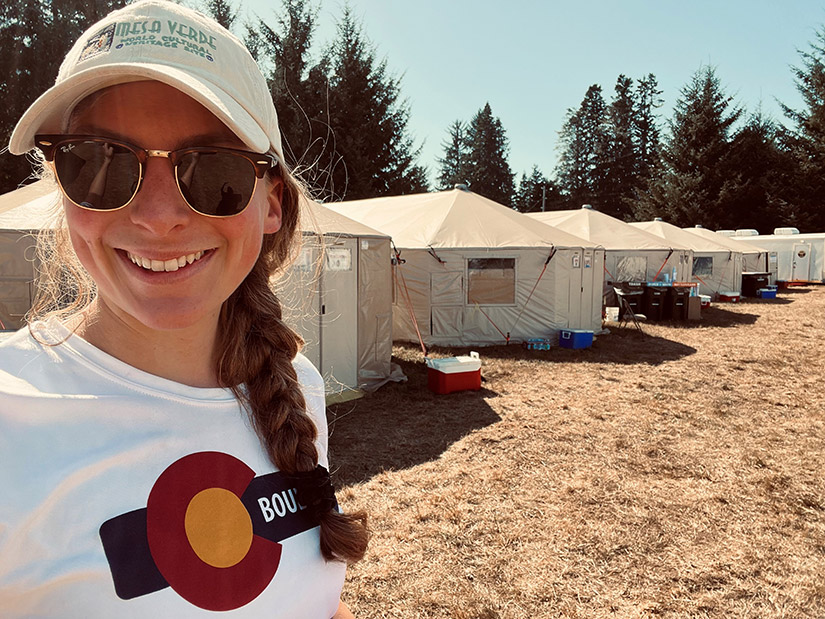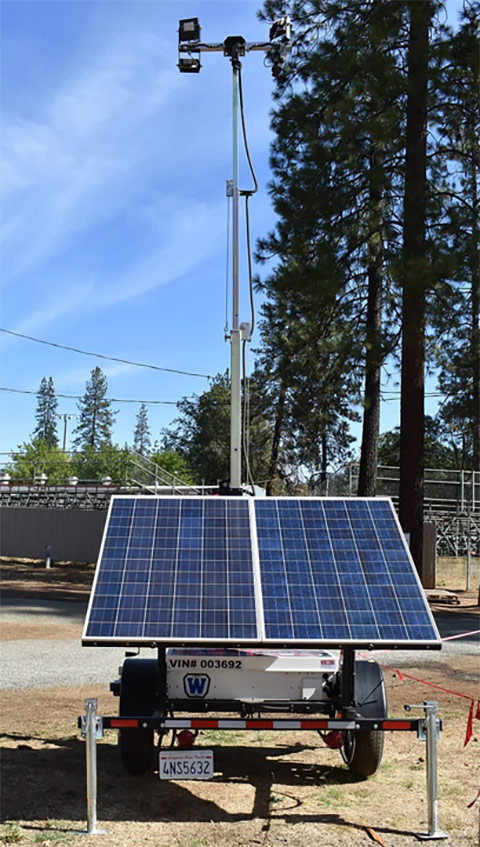NREL Helps US Forest Service Go Green After 2024 Lake Fire

What started as a small vegetation fire in Santa Barbara County in July quickly became one of the biggest wildfires of California’s 2024 fire season.
Over the first five days alone, the 2024 Lake Fire grew to over 28,000 acres and prompted evacuations of over 2,000 people. The fire would eventually consume 38,664 acres and, even with more than 3,500 firefighting personnel, took over a month of hard, dangerous work to contain. The 2024 Lake Fire was not an anomaly: Even with its massive size, it was only one of the thousands of wildfires in California this year.
When a wildfire threatens communities, wildland firefighters from all over the United States come together to mitigate its impact on ecosystems and prevent it from approaching inhabited areas. This means that much of the staging and preparation made by wildland firefighters often happens in remote areas with limited access to resources and supplies needed to sustain thousands of trained personnel. Although logistically challenging, deploying wildland firefighter basecamps closer to the fire, and further away from urban areas, also allows firefighters to more easily fight wildfires at their source.

One of the biggest challenges of supplying isolated wildland firefighter camps has always centered around fuel. Until recently, gasoline- and diesel-powered generators have been the go-to solution for providing electricity to much-needed catering, showering, handwashing, and coordination facilities. In addition, logistics staff planning firefighting efforts operate out of trailers or yurts that must have power for laptops, monitors, printers, HVAC systems, lights, and more.
Generators have been an effective way to ensure availability of power but are noisy, require regular refueling, and produce high levels of toxic emissions over time. The costs can add up as well, and it is estimated that in one year, U.S. Forest Service firefighting efforts use approximately $8 million or 2,000,000 gallons of diesel fuel—just to run generators in fire camps—enough to power more than 4,000 passenger cars for a year. Additionally, as digital technology becomes essential to improving the effectiveness of wildland firefighting, electricity demands continue to grow, and new solutions are needed to ensure uninterrupted energy generation in remote areas.

The U.S. Department of Energy’s National Renewable Energy Laboratory (NREL) has a long-running partnership with the U.S. Department of Agriculture, the U.S. Forest Service (USFS), and its Greening Fire Team (GFT)—a group of interagency employees dedicated to promoting sustainable firefighting operations and achieving net-zero environmental impact on all large fire incidents by 2030—with the aim to integrate more renewable energy methods and infrastructure into the national wildfire mitigation and control strategy. Over the last few years, this partnership included close collaboration with the USFS National Technology and Development Program (NTDP), a problem-solving organization that seeks and implements solutions to problems and technical challenges faced by agency employees and partners.
“Our work with NREL is resulting in excellent data collection of equipment loads and power usage analyses with the goal of making fire camps more efficient without compromising their mission or safety,” said Samuel Wu, national Greening Fire Team cochair and project manager at the NTDP. “NREL engineers have become critical team members for the NTDP project and for the wider scope of work pursued within the GFT.”
When NREL first began working with USFS over 20 years ago, researchers identified ways to improve the operational efficiency of fire camps, including pinpointing means to reduce energy use, water use, and waste generation. The laboratory and USFS share a vision of sustainability, and they collaborated on creating systems and plans to expand those practices—an initiative that was well received by staff and wildfire-fighting crews on the front lines of some of the most destructive fires in the United States.
NREL found that many fire camps had some renewable solar-powered solutions, but these were often limited in their utility and procured by individuals in limited quantities. By working together, multiple potential opportunities for improvement were identified and, over the last nine years, USFS developed the infrastructure needed to create systemic access to sustainable camp practices, including recycling, hardware adoption, and diversification of energy sources.

Expertise from NREL helped make the adoption of renewable energy infrastructure within fire camps a systematic process, with more effective guidance and management systems becoming available to administrators and fireteam leaders. One of the most recent examples is the adoption and installation of solar light towers and high-efficiency lighting to replace traditional diesel-powered lights. When practical, wildfire camp managers can request solar light towers, or hybrid towers with back-up diesel generators, to provide area lighting that reduces fuel usage for these assets by up to 100%, reducing the overall running costs by as much as 30%.
During the recent Lake Fire, NREL and the GFT successfully piloted several renewable energy solutions that put their ideas into practice. By integrating solar power and battery energy storage systems into fire camp operations, camp leaders were able to more efficiently power office trailers, light towers, and toilets and bring critical command and control systems online quickly. New types of solar panels allowed the Lake Fire basecamp to be more energy independent, with solar cells performing well even in smoky conditions. Additional access to batteries also ensured long runtimes, to supplement any drops in supply.

NREL and the USFS believe that sustainable methods in wildland firefighting can help improve the effectiveness of firefighting practices while lowering the human footprint in remote wilderness areas. Fire camps can strain the resources of nearby communities by using local water supplies and producing large amounts of trash, in addition to creating unnecessary pollution and ecological degradation from diesel-powered generators that can be alleviated with sustainable practices and renewable energy. Together with USFS and the GFT, NREL is advancing the integration of renewable energy methods into fire camps and making new types of energy generation accessible to wildland firefighters across the nation.
“It’s incredible what can be accomplished when we pair a deep understanding of complex issues in wildland fire operations with the expertise and perspective of NREL staff,” Wu said. “We look forward to continuing our collaboration with NREL and other partners as we strive to reduce waste and advance sustainability in fire incident operations.”
Learn more about the Forest Service’s Greening Fire Team, the NTDP, and how organizations can partner with NREL.

